A feud, or vendetta, is an extended argument between two groups of people, usually started as the result of an insult, violence, or even murder. Today the term is more popularly associated with celebrities and sports rivalries, but historical blood feuds were fairly commonplace, and there were even rules and laws—like dueling—that were set up in order to help resolve them. Some feuds managed to escalate beyond individual groups and families, and in a few extreme cases, like the War of the Roses, they even led to large-scale conflicts in which thousands were killed. Here are ten of the most famous examples:
10. Blues vs. Greens in the Byzantine Empire
You might think that sports rivalries are often taken a little too far, but modern soccer hooligans and hockey goons have got nothing on the fans of Byzantine-era chariot racing, who caused so much carnage that they were nearly able to overthrow the Emperor Justinian. At the time, chariot racing was the most popular form of entertainment in Constantinople, and supporters of the two most popular teams—known as the “Greens” and the “Blues” because of the color of their uniforms—resembled gangs more than they did sports fans. Chariot racing was so popular that the rival groups even managed to affect politics, and they were often known to shout out demands to the Emperor after a big win. When they weren’t functioning as de facto political parties, members of the Blues and the Greens engaged in a long-running feud that frequently resulted in fighting and even murders.
How it Ended:
The feud between the Blues and the Greens reached a fever pitch in 532 AD, when the infamous Nika Riots broke out after the government attempted to punish members of the groups for a series of killings perpetrated after an important chariot race. In a bizarre twist, the two groups briefly put aside their differences and turned on the Emperor, burning down much of the city and nearly taking over the rest. But after they were paid off by Justinian—a longtime supporter of their cause—the Blues turned on the Greens and left them to be slaughtered. In the ensuing bloodshed, thousands of Greens were killed by the imperial army.
9. Strangio-Nirtas vs. Pelle-Vottari-Romeos (The San Luca Feud)

While most of the feuds listed here came to an end years ago, Italy’s San Luca Feud is an example of a modern-day vendetta that is still ongoing. The conflict exists within a notorious crime organization called the ‘Ndrangheta, which is still one of the most powerful and violent mafias in all of Italy. The ‘Ndrangheta is organized into clans, and it was between two of these groups, the Strangio-Nirtas and Pelle-Vottari-Romeos, that the feud originally began. The first major incident occurred at a Carnival celebration in the village of San Luca in 1991, when a drunken brawl between young men from each side ended with the deaths of two members of the Strangio-Nirtas. This started a cycle of violence that lasted several years, and killings on both sides helped to rack up a shocking death toll. A truce was briefly declared in 2000, but the violence flared up again in 2007, after the wife of one of the higher-ups in the Strangio-Nirta clan was shot dead in San Luca.
How it Ended:
This killing proved to be a tipping point in the San Luca Feud, and it led to the conflict’s most deadly incident in August of 2007. In what has come to be known as the Duisburg massacre, six members of the Pelle-Romeo Clan were killed by a pair of gunmen who riddled the cars they were sitting in with more than 70 bullets. The sheer brutality of the crime led to a massive police investigation that resulted in the arrest of more than 30 members of the ‘Ndrangheta, among them several leaders of the Strangio-Nirta clan. Since then, it has been reported that a truce has once again been declared, but it remains to be seen if the San Luca Feud has finally come to an end.
8. The Black Donnellys vs. Biddulph Township
One of the most notorious feuds in Canada’s history concerns the “Black” Donnellys, an Irish immigrant family that managed to draw the ire of an entire town. The family arrived in Biddulph Township, Ontario in the mid-1840s. At the time, tensions between different factions of Irish immigrants in the area—among them the “Whiteboys” and the “Orangemen”—had escalated into an all-out feud, and it wasn’t long before the Black Donnelly’s, as they came to be known, had unwittingly entered the fray. The Donnellys were already known as a rough-and-tumble lot, but after showing up in Biddulph their criminal records grew considerably. Members of the family were arrested for everything from arson and theft to verbal assault, and though these offenses weren’t uncommon in the township, it seems that the Donnelly’s bad reputation made them a prime target for the local law enforcement. Soon, they were regarded as the town menace, and reports from the era describe a series of beatings, altercations, and livestock murders that occurred between the Donnellys and various townspeople. The feud was taken to a new level in 1857, when the family patriarch James Donnelly killed a local man with a crow bar during a drunken brawl. This, along with anger over violence surrounding a stage line that was started by one of James’s sons, set the stage for a bloody showdown.
How it Ended:
The Donnelly’s feud with Biddulph Township ended under mysterious and violent circumstances on February 4, 1880. In the early morning hours an angry mob—no doubt made up of the Donnelly’s enemies from in and around Biddulph—formed outside their house. The crowd entered the house and attacked the Donnellys with sticks, shovels, and other blunt objects. They managed to kill five members of the family, including James and his wife Johannah, before burning the house to the ground. No one was ever officially charged for the murders, and to this day the massacre of the Black Donnelly’s remains one of the most infamous crimes in Canadian history.
7. Clan Chattan vs. Clan Kay (The Battle of North Inch)
In medieval Scotland, feuding between rival clans and families was relatively common, and it wasn’t unusual for the differences to last for hundreds of years. These vendettas regularly ended in bloodshed, but perhaps never so spectacularly as in the case of the Battle of the Clans, also known as the Battle of the North Inch, an infamous clash between the Clan Chattan and the Clan Kay that occurred in 1396. Just who the Clan Kay were is still uncertain, though most claim they were either an affiliate of Clan Cameron—with whom the Chattans were known to have feuded for over 350 years—or an internal faction within Clan Chattan that sought control of the group. Either way, the tensions escalated to the point that the groups’ leaders decided on a most brutal solution: trial by combat. A makeshift battlefield, complete with wooden barrier walls, was erected near the river Tay, and 30 men from each group were selected to fight to the death. Whichever side had the last men standing would be declared the winner.
How it Ended:
On the day of the conflict, men from each of the feuding sides arrived armed with bows, swords, and axes. Spectators, including King Robert III, gathered around the battlefield. In what has become something of a legend, it is said that the Clan Chattan somehow ended up one man short, and was forced to pick up a substitute in the form of a diminutive harness maker known as Hal O’ the Wynd. He may have not looked like a fighter, but as the story goes, Hal O’ the Wynd proved to be a fierce warrior. He led the charge into battle, and following several minutes of horrific violence, all but one of the rival clan lay dead or dying on the battlefield ground, while 11 members of Clan Chattan had survived, and were declared the victors.
6. Grahams vs. Tewksburys (The Pleasant Valley War)
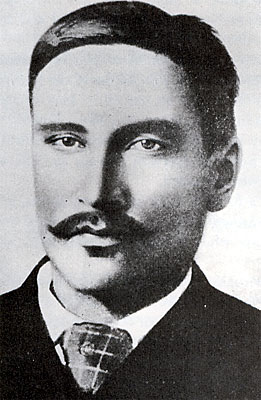
One of the most famous feuds of the American Old West was what has come to be known as the Pleasant Valley War, a years-long vendetta between two ranch families in Arizona. The trouble started in the 1880s, when differences arose between the Tewksburys, a family of sheepherders, and the cattle-raising Grahams. The two families regularly argued over the borders of their two properties, and both claimed that the other’s animals tore up their land and left it useless for grazing. Eventually, the conflict escalated into an outright war that claimed the lives of as many as 20 people. Locals from all around the area were drawn into the conflict, and both families are believed to have employed mercenaries as killers for hire, among them the infamous gunslinger Tom Horn.
How it Ended:
The conflict reached its height in September of 1887, when the Grahams surrounded the Tewksbury’s cabin and killed two men during a lengthy gunfight. A local lawman named Perry Owens found out about the ambush, and he later killed three members of the Graham faction after a gunfight broke out when he tried to make an arrest. But even the intervention of the law didn’t slow down the feuding families, and over the years the two continued fighting until there were only two men left standing: Ed Tewksbury and Tom Graham. Graham was murdered under mysterious circumstances in 1892, and though he was a prime suspect, Ed Tewksbury was never proven to be the killer. He was set free and lived until 1904, the only surviving participant in a years-long cycle of retaliatory violence that had managed to drive both families into extinction.
5. Alexander Hamilton vs. Aaron Burr
Alexander Hamilton and Aaron Burr were two of the key figures in the early history of the United States, but their function as founding fathers is often overshadowed by their legendary rivalry, which ended with a deadly duel in 1804. The tensions began in 1791 when Burr, a Democratic-Republican, was elected to the New York senate in place of Hamilton’s friend Phillip Schuyler, a Federalist. Hamilton took the defeat as a personal attack and developed a staunch dislike for Burr, and for the next several years both men frequently campaigned against one another. The competition came to a head in 1804, after Hamilton actively fought against Burr’s campaign for governor of New York and helped to ensure that a rival politician named Morgan Lewis won instead.
How it Ended:
Burr took Hamilton’s actions as an affront to his honor, and demanded that he apologize. Hamilton refused, and after several confrontations through letters and intermediaries, Burr challenged him to a duel. Hamilton accepted, and along with two seconds, the men traveled to a rocky bluff in Weehawken, New Jersey on July 11, 1804. It is often argued that Hamilton was a reluctant participant in the duel, and that he purposely fired his shot into the air. Still, all that is known for sure is that Hamilton’s bullet struck a tree branch over Burr’s head, and that Burr’s shot hit Hamilton in the stomach. He was taken back to his home in New York, where he died the next day.
4. Stalin vs. Trotsky
Just before the death of the famed Soviet revolutionary leader Vladimir Lenin, his two lieutenants Joseph Stalin and Leon Trotsky became embroiled in a bitter struggle for control over the newly formed USSR. Even prior to Lenin’s illness, there was no love lost between the two men, who had very different ideas about the way the socialist revolution should be conducted. They clashed after Stalin directly defied Trotsky’s orders during the Russian Civil War and the Polish-Soviet War, and Trotsky responded by being openly critical of Stalin during the Soviet Party Conference. After Lenin suffered a stroke in 1922, the feud escalated considerably. Trotsky was considered the smarter tactician of the two men, and he was widely acknowledged as Lenin’s preferred successor. But Stalin was shrewder and more skilled at negotiating backroom deals, and he quickly assembled a team of allies determined to see Trotsky destroyed.
How it Ended:
Although outnumbered by political opponents, Trotsky continued to voice his opposition to Stalin and his allies even after Lenin’s death in 1924. He briefly managed to gain popular support, and to many he was still regarded as the natural successor to Lenin. But Stalin soon began using the Soviet Secret Police as a means of intimidation, and before long support for Trotsky had largely been stamped out. With his new power, Stalin saw to it that Trotsky was removed from the party and exiled from the USSR in 1928. Trotsky eventually ended up in Mexico where, on Stalin’s orders, he was assassinated by a Soviet operative in 1940.
3. The 47 Ronin vs. Kira Yoshinaka (The Ako Vendetta)

In Samurai history, there’s no more famous story of vendetta than the tale of the 47 Ronin, which has become one of Japan’s most treasured pieces of national folklore. As the story goes, the feud originally began in the 1600s between Asano Nagonori, a feudal lord, and Kira Yoshinaka, an official who worked for the Shogun, the head military official in Japan. Kira was supposedly a rude and ill-tempered man, and it’s said he regularly disrespected the more unflappable Asano. After repeated insults, Asano finally drew his sword and attacked Kira, but he only succeeded in slashing the other’s face before he was subdued and arrested. For his crime, Asano was forced to commit seppuku, a ritualistic suicide that’s better known in the West as “hara-kiri.” Asano’s death meant that his Samurai retainers had become Ronin—warriors without a master or purpose. Most went their separate ways, but a group of 47 loyal members, led by Oishi Yoshio, swore to avenge Asano’s death.
How it Ended:
Kira was wary that the Ronin would try to seek revenge, so they were forced to lie in wait for over a year, carefully disguising their motives by taking on menial jobs and pretending to be poor and undisciplined. But two years after Asano’s death, the Ronin finally attacked. They converged on Kira’s mansion, and after defeating several rival Samurai in combat, they found Kira cowering in a back room and killed him by cutting off his head. They took the head with them and placed it on their master Asano’s tomb before turning themselves in to the authorities. Though they may have been victorious in the feud, the 47 Ronin were still charged with murder, and they were forced to commit seppuku in the same fashion as their master.
2. Al Capone vs. Bugs Moran
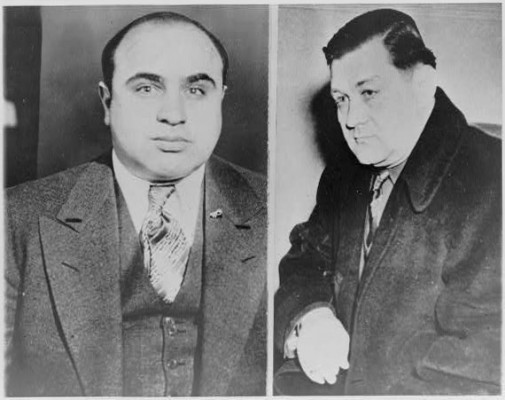
Prohibition-era gangsters Al Capone and Bugs Moran managed to control the Chicago underworld for most of the 1920s. They ran liquor, operated casinos, and opened brothels, all with little fear of retaliation from the police. What both men did fear, though, was each other. For years prior to Capone’s imprisonment, the two engaged in a bloody feud that included robbery, arson, and murder. The trouble started when Capone’s Southside Italian gang started to rise to power through violence and intimidation. Moran’s Irish Northsiders took a strong dislike to Capone’s brutal tactics, and Moran himself regularly lambasted Capone in the press, calling him “Scarface” and a “grease ball.” On more than one occasion, Moran and his associates performed drive-by shootings on Capone’s cars and businesses, and both men had properties owned by the other burned to the ground. In one particularly grisly incident, Moran’s crew abducted Capone’s personal bodyguard and tortured him for hours before killing him and ditching the body.
How it Ended:
Capone and Moran’s organizations continued to trade punches throughout the late 1920s. Moran made several attempts on Capone’s life, and he regularly had his gang raid Capone’s shipments of illegal liquor. The tension finally got the better of Capone in 1929, when he allegedly ordered the St. Valentine’s Day Massacre, which saw seven of Moran’s men lined up and shot hundreds of times with Tommy guns. The massacre marked the beginning of the end of Moran’s criminal empire, but it also drew the ire of the federal government, which arrested Capone on tax evasion charges two years later. After being released, Capone was never able to reestablish his criminal empire. Moran, meanwhile, was later arrested for bank robbery, and died in prison at the age of 65.
1. Hatfields vs. McCoys
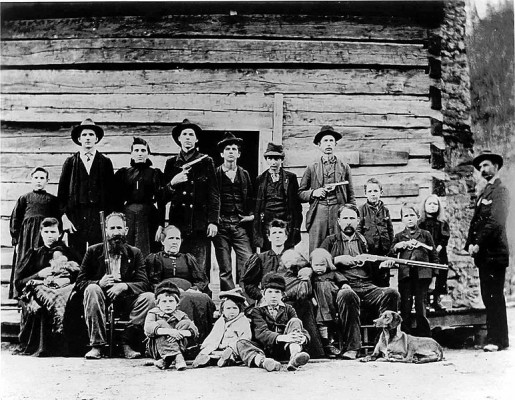
There’s simply no feud more noteworthy than the legendary conflict between West Virginia’s Hatfield family and Kentucky’s McCoys, which has come to be the most famous historical example of the destructive power of vendettas. The differences between the wealthy Hatfields and the more working class McCoys started during the Civil War. The pro-Confederate Hatfields made no secret of their disdain for the McCoy’s support of the Union, and they were even suspected of killing one of the McCoys who served in the Union army. But the feud didn’t really begin to gain steam until 1878, when a dispute over ownership of a pig ended with the McCoys killing one of the Hatfields. From here, the conflict escalated into an all-out war, with both sides regularly perpetrating killings, beatings, and kidnappings against the other. In one of the feud’s most dramatic chapters, Roseanna McCoy began an affair with one of the Hatfield boys, and the familial strains caused by the relationship (which was eventually abandoned) led to a series of brutal murders on both sides.
How it Ended:
The feud reached its bloody peak in 1888. In what has come to be known as the New Year’s Night Massacre, a group of Hatfields attacked the McCoy cabin in the middle of the night. After opening fire on the cabin, killing two children, and brutally beating their mother, the men burned the house down. This incident, along with a string of other killings during the 1880s, eventually got the law involved, and the governors of both Kentucky and West Virginia even deployed state militias to help get the situation under control. After a manhunt, several of the Hatfields were arrested for their part in the New Year’s Night massacre, and at least seven were given life sentences in prison.
In 1891, after ten years of bitter conflict and more than a dozen deaths, the two families finally agreed to a truce, and from there the feud eventually eroded. Amazingly, and despite their family histories of violence against one another, descendants of the Hatfields and McCoys have regularly had friendly reunions in the years since, most recently in 2003. In perhaps the most bizarre meeting of all, the two groups even appeared as rival contestants on the TV game show Family Feud.

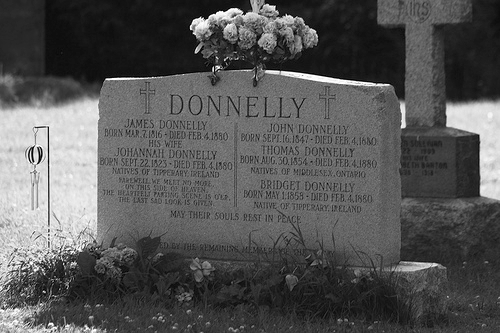


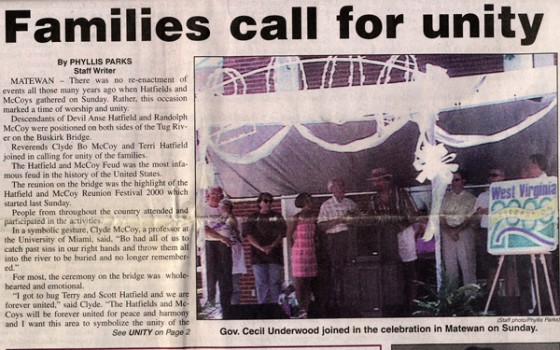
27 Comments
To me it’s all about Deion Sanders and Jerry Rice.
this is trash
I know bro I know
this should have been actual family feud not this trash
Capulets vs Montagues, helloo??? I mean, come on, it’s one of the most famous rivalries 🙂
Also based in fiction.
Ummm, they weren’t real people…They were characters in a book!
I don’t think a feud list is complete with Noel and Liam Gallagher. Those two fight an awful lot, it seems like.
what about some other big family feuds in southern italy, like the libergolis-romito feud in the gargano mountains. started in 1979 to present. death toll approx 100 family members both sides.
How could you miss the feud between Fort Worth and Dallas that began in the 1800s and fizzled out in 1974?
The history channel is airing a three-part miniseries titled Hatfields & McCoys, starring Kevin Costner as William Anderson “Devil Anse” Hatfield and co-starring Bill Paxton as Randolph “Ole Ran’l” McCoy. Last part is on Monday June 11th.
so the Disciple -v- Stone Feud does not merit mention?
its been Chicago’s bloodiest since the 1960s
.There is a slight error in the section on the Hatfields and McCoys section; you state that the families were on the game show family feud in 2003. This is incorrect. They were on the show in 1979. In 2003 after the 9-11 attack on the trade center. The two families got together and singed a symbolic peace treaty, as an example to all Americans, that we need to all pull together in a time of crises
No mistake. We didn’t say what year they were on the Family Feud, but we appreciate you providing the date. Thanks.
me and my mother think were mccoys 70 years ago marybelle mullins was adopted by italy fields and charlie mullins from virginia charles mullins was a abulance driver and imbsalmer he picked up a dead mccoy mother and children and said he found marybelle mccoy in the closet she didnt have a birth certificate so they guessed she was about 10 moths old and guessed her birthdate we have never found out qaboutwhat mccoy family she was from .i am marybells daughter i would like to know ourreal family.alk i know is that her mom lived in pikeville kentucky and west virgiia state line near the tug valley river. if anyone knows who that family was please contact italy at 567-8555388. thank you for helping. italy czczeli 219 east mcpherson hwy apt3 clyde ohio 43410.
Re- number 7, Clan Chattan:- interesting read, I’m descended from Hal O’ The Wynd, who was my clan progenator.
In recognition for his services to Clan Chattan, Henry was permitted to start a clan/sept of his own with its own name, meanwhile owing allegiance to Clan MacPherson, a main Clan within the Confederation of Clan Chattan.
Though described as diminutive in your story, he was short (but not diminutive) and very strong, being a blacksmith, as well as reputedly being a good archer and swordsman. According to sources “at or around” the time, he got Clan Chattan off to a flying start by whacking one of the opposition with an arrow. Then another. Then he left line of battle and sat down, pleased at having shortened the odds and giving the others a chance to finish it off. As the swords and axes were swinging and lobbing off arms and cleaving heads, the captain of Clan Chattan implored Henry to re-join the battle. Up he got, big sword in his hands and started swinging left and right with great skill and dexterity. The end of the battle was signalled by the one and only opposition survivor high-tailing it from the gory field, jumping into the River Tay and swimming as fast and far as possible. I should add here that Henry was sponsored to join the Chattan side, to the extent that it would leave him looked after for the rest of his natural life ! The trial by combat was witnessed by an audience which included the Scottish King, plus many Scottish, English and foreign nobles. Like an extreme edition of “Gladiators” or “Ninja Warrior”
The Clan Henry started became known as “Sliochd na Gobha Chrom” or “Clan of the Bow-Legged Blacksmith !” Settling in the Highlands of Perthshire and Invernes-shire, in time, the more convenient versions of “Gow” and “MacGowan” were introduced. My family all come from the Blair Atholl district of North Perthshire.
This isn't even a Top 10 without the Capulets and the Montagues. Seriously. What a pile of wank.
Not trying to embarrass you, but your do realize that the Capulets and Montagues are fictional characters in a fictional play. The families and people on this list actually existed.
What about Springfield vs. Shelbyville?
Oh, that is brilliant, but not based in reality. Although the Simpsons fan in me agrees with you.
Well they weren’t completely fictional they were political party’s but yeah I agree they don’t really count
True story, in my home town of Corning, California, (pop. 7,000) there are two hardware stores: Hatfield's Ace Hardware and McCoy's Farm and Hardware.
interesting story of the mccoys and hatfields! I've never heard of them even in history books and i'm 26! definently opens your mind to other avenue about how much knowledge is out there and it's accessible if you reach out and grab it!
Where is Tupac and Biggie?
Cmon now ???
The Hatfield and McCoy descendants appeared on Family Feud? Their ancestors must have been rolling over in their graves.
Awesome list! Very well done. My favorite is Capone vs Moran. One of my favorites quotes from Capone in the Untouchables:
"You put one of ours in the hospital, we put one of yours in the morgue…"